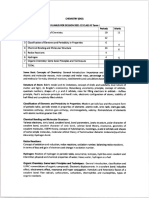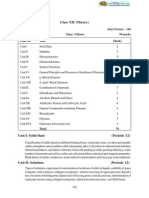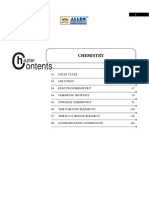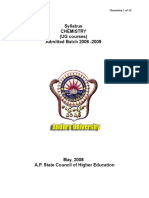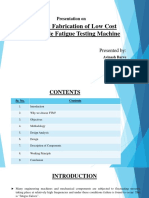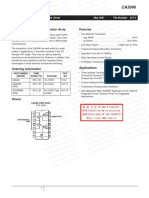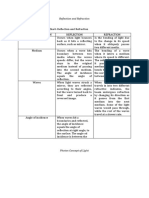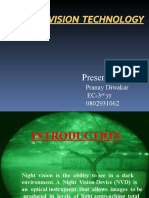CBSE Class 12 Chemistry Syllabus
CBSE Class 12 Chemistry Syllabus
Uploaded by
Awantika ShivhareCopyright:
Available Formats
CBSE Class 12 Chemistry Syllabus
CBSE Class 12 Chemistry Syllabus
Uploaded by
Awantika ShivhareOriginal Description:
Copyright
Available Formats
Share this document
Did you find this document useful?
Is this content inappropriate?
Copyright:
Available Formats
CBSE Class 12 Chemistry Syllabus
CBSE Class 12 Chemistry Syllabus
Uploaded by
Awantika ShivhareCopyright:
Available Formats
Syllabus 2022-2023
Class: XII
CHEMISTRY (CODE NO. 043)
COURSE STRUCTURE
Total Times: 3 hrs Total Marks: 70
S.No UNIT NAME MARKS
I Solutions 7
II Electrochemistry 9
III Chemical Kinetics 7
IV d -and f -Block Elements 7
V Coordination Compounds 7
VI Haloalkanes and Haloarenes 6
VII Alcohols, Phenols and Ethers 6
VIII Aldehydes, Ketones and Carboxylic Acids 8
IX Amines 6
X Biomolecules 7
TOTAL 70
UNIT-II: SOLUTIONS
Types of solutions, expression of concentration of solutions of solids in liquids,
solubility of gases in liquids, solid solutions, Raoult's law, colligative properties -
relative lowering of vapour pressure, elevation of boiling point, depression of freezing
point, osmotic pressure, determination of molecular masses using colligative
properties, abnormal molecular mass, Van't Hoff factor
Class XII www.vedantu.com 1
UNIT-III: ELECTROCHEMISTRY
Redox reactions, EMF of a cell, standard electrode potential, Nernst equation and its
application to chemical cells, Relation between Gibbs energy change and EMF of a
cell, conductance in electrolytic solutions, specific and molar conductivity, variations
of conductivity with concentration, Kohlrausch's Law, electrolysis and law of
electrolysis (elementary idea), dry cell-electrolytic cells and Galvanic cells, lead
accumulator, fuel cells, corrosion.
UNIT-IV: CHEMICAL KINETICS
Rate of a reaction (Average and instantaneous), factors affecting rate of reaction:
concentration, temperature, catalyst; order and molecularity of a reaction, rate law and
specific rate constant, integrated rate equations and half-life (only for zero and first
order reactions), concept of collision theory (elementary idea, no mathematical
treatment), activation energy, Arrhenius equation.
UNIT-VIII: d and f BLOCK ELEMENTS
General introduction, electronic configuration, occurrence and characteristics of
transition metals, general trends in properties of the first-row transition metals –
metallic character, ionization enthalpy, oxidation states, ionic radii, colour, catalytic
property, magnetic properties, interstitial compounds, alloy formation, preparation and
properties of K2Cr2O7 and KMnO4.
Lanthanoids –
Electronic configuration, oxidation states, chemical reactivity and lanthanoid
contraction and its consequences.
Actinoids - Electronic configuration, oxidation states and comparison with
lanthanoids.
UNIT-IX: COORDINATION COMPOUNDS
Coordination compounds - Introduction, ligands, coordination number, colour,
magnetic properties and shapes, IUPAC nomenclature of mononuclear coordination
compounds. Bonding, Werner's theory, VBT, and CFT; structure and stereoisomerism,
the importance of coordination compounds (in qualitative analysis, extraction of
metals and biological system).
Class XII www.vedantu.com 2
UNIT-X: HALOALKANES AND HALOARENES.
Haloalkanes: Nomenclature, nature of C–X bond, physical and chemical properties,
optical rotation mechanism of substitution reactions.
Haloarenes: Nature of C–X bond, substitution reactions (Directive influence of
halogen in monosubstituted compounds only). Uses and environmental effects of -
dichloromethane, trichloromethane, tetrachloromethane, iodoform, freons, DDT.
UNIT-XI: ALCOHOLS, PHENOLS AND ETHERS
Alcohols: Nomenclature, methods of preparation, physical and chemical properties (of
primary alcohols only), identification of primary, secondary and tertiary alcohols,
mechanism of dehydration, uses with special reference to methanol and ethanol.
Phenols: Nomenclature, methods of preparation, physical and chemical properties,
acidic nature of phenol, electrophilic substitution reactions, uses of phenols.
Ethers: Nomenclature, methods of preparation, physical and chemical properties,
uses.
UNIT-XII: ALDEHYDES, KETONES AND CARBOXYLIC ACIDS
Aldehydes and Ketones: Nomenclature, nature of carbonyl group, methods of
preparation, physical and chemical properties, mechanism of nucleophilic addition,
reactivity of alpha hydrogen in aldehydes, uses.
Carboxylic Acids: Nomenclature, acidic nature, methods of preparation, physical and
chemical properties; uses.
UNIT-XIII: AMINES
Amines: Nomenclature, classification, structure, methods of preparation, physical and
chemical properties, uses, identification of primary, secondary and tertiary amines.
Diazonium salts: Preparation, chemical reactions and importance in synthetic organic
chemistry.
Class XII www.vedantu.com 3
UNIT-XIV: BIOMOLECULES
Carbohydrates - Classification (aldoses and ketoses), monosaccharides (glucose and
fructose), D-L configuration oligosaccharides (sucrose, lactose, maltose),
polysaccharides (starch, cellulose, glycogen); Importance of carbohydrates.
Proteins -Elementary idea of - amino acids, peptide bond, polypeptides, proteins,
structure of proteins - primary, secondary, tertiary structure and quaternary structures
(qualitative idea only), denaturation of proteins; enzymes. Hormones - Elementary
idea excluding structure.
Vitamins - Classification and functions.
Nucleic Acids: DNA and RNA.
PRACTICALS
Total Times: 3 hrs Total Marks: 30
Evaluation Scheme for Examination Marks
Volumetric Analysis 08
Salt Analysis 08
Content Based Experiment 06
Project Work 04
Class record and viva 04
TOTAL 30
PRACTICAL SYLLABUS
Micro-chemical methods are available for several of the practical experiments,
wherever possible such techniques should be used.
A. Surface Chemistry
(a) Preparation of one lyophilic and one lyophobic sol
Lyophilic sol - starch, egg albumin and gum
Class XII www.vedantu.com 4
Lyophobic sol - aluminium hydroxide, ferric hydroxide, arsenous sulphide.
(b) Dialysis of sol-prepared in (a) above.
(c) Study of the role of emulsifying agents in stabilizing the emulsion of different oils.
B. Chemical Kinetics
(a) Effect of concentration and temperature on the rate of reaction between Sodium
Thiosulphate and Hydrochloric acid.
(b) Study of reaction rates of any one of the following:
(i) Reaction of Iodide ion with Hydrogen Peroxide at room temperature using
different concentrations of Iodide ions.
(ii) Reaction between Potassium Iodate, (KIO3) and Sodium Sulphite:
(Na2SO3) using starch solution as an indicator (clock reaction).
C. Thermochemistry
Any one of the following experiments
(a) Enthalpy of dissolution of Copper Sulphate or Potassium Nitrate.
(b) Enthalpy of neutralization of strong acid (HCI) and strong base (NaOH).
(c) Determination of enthaply change during interaction (Hydrogen bond formation)
between Acetone and Chloroform.
D. Electrochemistry
Variation of cell potential in Zn/Zn2+|| Cu2+/Cu with change in concentration of
electrolytes (CuSO4 or ZnSO4) at room temperature.
E. Chromatography
(a) Separation of pigments from extracts of leaves and flowers by paper
chromatography and determination of Rf values.
(b) Separation of constituents present in an inorganic mixture containing two cations
only (constituents having large difference in Rf values to be provided).
Class XII www.vedantu.com 5
F. Preparation of Inorganic Compounds
Preparation of double salt of Ferrous Ammonium Sulphate or Potash
Alum. Preparation of Potassium Ferric Oxalate.
G. Preparation of Organic Compounds
Preparation of any one of the following compounds
i) Acetanilide ii) Di -benzalAcetone iii) p-Nitroacetanilide iv) Aniline yellow or 2 -
Naphthol Anilinedye.
H. Tests for the functional groups present in organic compounds:
Unsaturation, alcoholic, phenolic, aldehydic, ketonic, carboxylic and amino (Primary)
groups.
I. Characteristic tests of carbohydrates, fats and proteins in pure samples and
their detection in given foodstuffs.
J. Determination of concentration/ molarity of KMnO4 solution by titrating it
against a standard solution of:
(a) Oxalic acid,
(b) Ferrous Ammonium Sulphate
(Students will be required to prepare standard solutions by weighing themselves).
K. Qualitative analysis
Determination of one anion and one cation in a given salt
Cation:
Pb2+, Cu2+, As 3+, Al 3+, Fe3+, Mn2+, Ni2+, Zn2+, Co2+, Ca2+, Sr2+, Ba2+, Mg2+, NH4+
Anions:
(CO3)2- , S2- , NO2- , SO32- , SO42- , NO3-, Cl-, Br- , I- , PO43- , C2O42- ,CH3COO-
(Note: Insoluble salts excluded)
Class XII www.vedantu.com 6
INVESTIGATORY PROJECT
Scientific investigations involving laboratory testing and collecting information from
other sources A few suggested Projects.
● Study of the presence of oxalate ions in guava fruit at different stages of
ripening.
● Study the quantity of casein present in different samples of milk.
● Preparation of soybean milk and its comparison with natural milk with respect
to curd formation, the effect of temperature, etc.
● Study of the effect of Potassium Bisulphate as a food preservative under various
conditions (temperature, concentration, time, etc.)
● Study of digestion of starch by salivary amylase and effect of pH and
temperature on it.
● Comparative study of the rate of fermentation of the following materials: wheat
flour, gram flour, potato juice, carrot juice, etc.
● Extraction of essential oils present in Saunf (aniseed), Ajwain (carum), Illaichi
(cardamom).
● Study of common food adulterants in fat, oil, butter, sugar, turmeric power,
chilli powder and pepper.
Note: Any other investigatory project, which involves about 10 periods of work, can
be chosen with the approval of the teacher.
Class XII www.vedantu.com 7
QUESTION PAPER DESIGN FOR CHEMISTRY CLASS –XII (2022-23)
S.No Domains Marks Weightage %
1 Remembering and Understanding:
Exhibit memory of previously learned material 28 40
by recalling facts, terms, basic concepts and
answers. Demonstrate understanding of facts
and ideas by organizing, comparing, translating,
interpreting, giving descriptions and stating
main ideas.
2 Applying:
21 30
Solve problems to new situations by applying
acquired knowledge, facts, techniques and rules
in a different way
3 Analyzing, Evaluating and Creating:
Examine and break information into parts by
identifying motives or causes. Make inferences
and find evidence to support generalizations.
Present and defend opinions by making 21 30
judgments about information, the validity of
ideas or quality of work based on a set of
criteria. Compile information together in a
different way by combining elements in a new
pattern or proposing alternative solutions.
PRESCRIBED BOOKS
1. Chemistry Part -I, Class-XII, Published by NCERT.
2. Chemistry Part -II, Class-XII, Published by NCERT.
3. Laboratory Manual of Chemistry, Class XI Published by NCERT
4. Other related books and manuals of NCERT including multimedia and online
sources
Class XII www.vedantu.com 8
You might also like
- Lecture Notes in Chem. 260 Chemical Kinetics (Physical Chemistry II) Joel R. Salazar, PH.DDocument59 pagesLecture Notes in Chem. 260 Chemical Kinetics (Physical Chemistry II) Joel R. Salazar, PH.Dbinseung skzNo ratings yet
- Schaum's Easy Outline of Organic Chemistry, Second EditionFrom EverandSchaum's Easy Outline of Organic Chemistry, Second EditionRating: 3.5 out of 5 stars3.5/5 (2)
- Chemistry Second-YearDocument5 pagesChemistry Second-YearSantanu DasNo ratings yet
- Chemistry PortionDocument12 pagesChemistry PortionVivek KumbhaniNo ratings yet
- 12th Chemistry Syllabus (2023-24)Document7 pages12th Chemistry Syllabus (2023-24)ts397199No ratings yet
- Chemistry SrSec 2022-23Document3 pagesChemistry SrSec 2022-23Afzal MohammedNo ratings yet
- Class XII (Theory) : One Paper Time: 3 Hours 70 Marks Unit No. Title MarksDocument6 pagesClass XII (Theory) : One Paper Time: 3 Hours 70 Marks Unit No. Title MarksjigmeetNo ratings yet
- CBSE Class 12 Chemistry Syllabus 2023 24Document7 pagesCBSE Class 12 Chemistry Syllabus 2023 24IbinNo ratings yet
- Class 12 Chemistry Syllabus 2023-24Document3 pagesClass 12 Chemistry Syllabus 2023-24Rooh KSHIVNo ratings yet
- Adobe Scan 10-May-2024 (1)Document3 pagesAdobe Scan 10-May-2024 (1)pankajkumar9608358074No ratings yet
- CBSE Class 11 Chemistry SyllabusDocument7 pagesCBSE Class 11 Chemistry SyllabusAdityaNo ratings yet
- CLASS XII (2020-21) (Theory) Total Periods (Theory 98 + Practical 36) Time: 3 Hours 70 Marks Unit No. Title No. of Periods MarksDocument3 pagesCLASS XII (2020-21) (Theory) Total Periods (Theory 98 + Practical 36) Time: 3 Hours 70 Marks Unit No. Title No. of Periods MarksAlok RajNo ratings yet
- 130 Chemistry Xi, Xii 2023 24Document11 pages130 Chemistry Xi, Xii 2023 24s6580150No ratings yet
- Chemistry - SrSec - 2023 24 Pages 7 13Document7 pagesChemistry - SrSec - 2023 24 Pages 7 13Mihir MishraNo ratings yet
- Chemistry - SrSec - 2023 24 6 9Document4 pagesChemistry - SrSec - 2023 24 6 9k5he06pny2No ratings yet
- REVISED SR SEC Chemistry 2020 21Document8 pagesREVISED SR SEC Chemistry 2020 21jacobNo ratings yet
- Adobe Scan 10 Sep 2023Document3 pagesAdobe Scan 10 Sep 2023lavyasharma566No ratings yet
- Syllabus Session-2020-21 Class - Xii Subject: Chemistry (Code: 043)Document11 pagesSyllabus Session-2020-21 Class - Xii Subject: Chemistry (Code: 043)lupsadofyevusra.comNo ratings yet
- 2024-25 CBSE 12 Chemistry Syllabus AnalysisDocument7 pages2024-25 CBSE 12 Chemistry Syllabus AnalysisMD Shamim MondalNo ratings yet
- UP Board Class 12 Chemistry Syllabus Reduced 2020 21Document7 pagesUP Board Class 12 Chemistry Syllabus Reduced 2020 21parvej alamNo ratings yet
- Class-XII Chemistry: S No Unit Portion To Be ReducedDocument3 pagesClass-XII Chemistry: S No Unit Portion To Be ReducedVarun SinghNo ratings yet
- Chemistry SrSec 2024-25Document7 pagesChemistry SrSec 2024-25jmdhandicraft3No ratings yet
- 27 ChemistryDocument15 pages27 ChemistryKB SinghNo ratings yet
- Annexure 'I': Syllabus CHEMISTRY (043) CLASS-XII - (2013-14)Document7 pagesAnnexure 'I': Syllabus CHEMISTRY (043) CLASS-XII - (2013-14)Ravi DharawadkarNo ratings yet
- Chemistry 12th Syllabus PDF 2021-22Document7 pagesChemistry 12th Syllabus PDF 2021-22Garima SrivastavaNo ratings yet
- S No Unit Portion To Be Reduced: CHEMISTRY (043) Class XIDocument4 pagesS No Unit Portion To Be Reduced: CHEMISTRY (043) Class XIA.Mohammad idhrisNo ratings yet
- S No Unit Portion To Be Reduced: CHEMISTRY (043) Class XIDocument4 pagesS No Unit Portion To Be Reduced: CHEMISTRY (043) Class XIPrem KalukuriNo ratings yet
- CLASS XII (2018-19) Theory: Unit No. Title No. of Periods MarksDocument4 pagesCLASS XII (2018-19) Theory: Unit No. Title No. of Periods MarksPraynshu ChoudharyNo ratings yet
- Chemistry WorksheetDocument4 pagesChemistry WorksheetLIYA ASKARNo ratings yet
- 12 2011 Syllabus ChemistryDocument7 pages12 2011 Syllabus Chemistryavpjerk007No ratings yet
- Chemistry 2021-22Document2 pagesChemistry 2021-22Nishant GoelNo ratings yet
- Chemistry Cl. XIIDocument7 pagesChemistry Cl. XIIRakeshKumarJowai25% (4)
- Chemistry Class XIDocument5 pagesChemistry Class XILuciefer 0035No ratings yet
- Chemistry SyllabusDocument5 pagesChemistry SyllabusDushyant RohillaNo ratings yet
- CHEMDocument3 pagesCHEMVardhan AmanapuNo ratings yet
- XII Chemistry 2024-25Document197 pagesXII Chemistry 2024-25akash528tmyNo ratings yet
- Chemistry 12Document8 pagesChemistry 12Vishesh GoyalNo ratings yet
- Term - Wise Syllabus Session-2019-20 Class - XII Subject: Chemistry (Code: 043)Document4 pagesTerm - Wise Syllabus Session-2019-20 Class - XII Subject: Chemistry (Code: 043)Tushar YadavNo ratings yet
- Term - Wise Syllabus Session-2019-20 Class - XII Subject: Chemistry (Code: 043)Document4 pagesTerm - Wise Syllabus Session-2019-20 Class - XII Subject: Chemistry (Code: 043)Naeem RehmanNo ratings yet
- Class XII (Theory) : One Paper Time: 3 Hours 70 Marks Unit No. Title MarksDocument7 pagesClass XII (Theory) : One Paper Time: 3 Hours 70 Marks Unit No. Title MarksJinu MadhavanNo ratings yet
- 12 Chemistry 20Document15 pages12 Chemistry 20Aranyak NagNo ratings yet
- 2014 Chemistry Cbse Sample PaperDocument26 pages2014 Chemistry Cbse Sample PaperVijaykumar Shukla100% (1)
- Chemistry SyllabusDocument28 pagesChemistry SyllabusDhankar SugreevNo ratings yet
- Syllabus of ChemDocument6 pagesSyllabus of ChemJaspreet SinghNo ratings yet
- 2014 Syllabus 12 ChemistryDocument7 pages2014 Syllabus 12 ChemistryforbugmenotNo ratings yet
- 12 Revised Chemistry 21Document11 pages12 Revised Chemistry 21Trew GulackNo ratings yet
- CBSE Class 12 Chemistry Deleted Syllabus Portion For 2020 21Document2 pagesCBSE Class 12 Chemistry Deleted Syllabus Portion For 2020 21Sai gokulNo ratings yet
- ChemistryDocument185 pagesChemistryutkarshgourfake8No ratings yet
- Syllabus Chemistry (UG Courses) Admitted Batch 2008 - 2009Document33 pagesSyllabus Chemistry (UG Courses) Admitted Batch 2008 - 2009ArunNo ratings yet
- Check List For Chemistry 2024Document3 pagesCheck List For Chemistry 2024hellobishnoi1744No ratings yet
- CBSE Class 12 Chemistry Syllabus: Class Xii (Theory) Total Periods 180 Unit I: Solid State (Periods 12)Document6 pagesCBSE Class 12 Chemistry Syllabus: Class Xii (Theory) Total Periods 180 Unit I: Solid State (Periods 12)anas jawaidNo ratings yet
- MP-Board-Syllabus-for-Class-12-Chemistry as of new patternDocument6 pagesMP-Board-Syllabus-for-Class-12-Chemistry as of new patternthemoodyyetpeacefulsoulNo ratings yet
- ABf 5 y 8 AKOl CKTKS1 HLCWDocument8 pagesABf 5 y 8 AKOl CKTKS1 HLCWdeepakpratap3232No ratings yet
- 3 Complete Note1666703467Document115 pages3 Complete Note1666703467tummyodeyemiNo ratings yet
- 12 Syllabus 2024 ChemistryDocument8 pages12 Syllabus 2024 Chemistryharshitaarya740No ratings yet
- Chemistry Class 12 Syllabus - 2017-2018 CBSEsyllabus PDFDocument9 pagesChemistry Class 12 Syllabus - 2017-2018 CBSEsyllabus PDFzeeshan khanNo ratings yet
- Xii Study Material (2023-24) (1) - CDocument118 pagesXii Study Material (2023-24) (1) - CKrishna TrivediNo ratings yet
- Course Structure: Unit Title MarksDocument3 pagesCourse Structure: Unit Title MarksAjay00388No ratings yet
- C B S E Chemistry - SrSec - 2022-23Document8 pagesC B S E Chemistry - SrSec - 2022-23divyaNo ratings yet
- Chemoselective and Bioorthogonal Ligation Reactions: Concepts and ApplicationsFrom EverandChemoselective and Bioorthogonal Ligation Reactions: Concepts and ApplicationsW. Russ AlgarNo ratings yet
- Design & Fabrication of Low Cost Small-Scale Fatigue Testing MachineDocument12 pagesDesign & Fabrication of Low Cost Small-Scale Fatigue Testing MachinekshitijNo ratings yet
- NycoCard Reader Instruction Manual BookDocument4 pagesNycoCard Reader Instruction Manual Bookbhezos100% (3)
- Top 3 Alumina PCB Manufacturers in The WorldDocument10 pagesTop 3 Alumina PCB Manufacturers in The WorldjackNo ratings yet
- General Purpose NPN Transistor Array Features: Data Sheet May 2001 File Number 341.5Document5 pagesGeneral Purpose NPN Transistor Array Features: Data Sheet May 2001 File Number 341.5EFranNo ratings yet
- RAM Connection Standalone CE Report - 11Document2 pagesRAM Connection Standalone CE Report - 11dineshNo ratings yet
- January 2024Document5 pagesJanuary 2024machaviseNo ratings yet
- NEETJEE Main Physics Chapter Wise Solved Papers VOLUME-IV 2Document31 pagesNEETJEE Main Physics Chapter Wise Solved Papers VOLUME-IV 2palakprachi31No ratings yet
- Aec Lab ManualDocument97 pagesAec Lab ManualKaleru ManideepkumarNo ratings yet
- MDSP Mastery Part 2-Answer KeyDocument2 pagesMDSP Mastery Part 2-Answer KeyLorence Cardenas100% (1)
- Em Pmi375 T800 PDFDocument6 pagesEm Pmi375 T800 PDFmaaathanNo ratings yet
- Lecture 4 Evaporation IIDocument18 pagesLecture 4 Evaporation IIOmar MontesNo ratings yet
- Jurnal Adji Dwi Saputra 1902014Document10 pagesJurnal Adji Dwi Saputra 1902014Rezky MuhammadNo ratings yet
- Taller VI - Seguna Ley, Balance de Entropía - Segunda ParteDocument2 pagesTaller VI - Seguna Ley, Balance de Entropía - Segunda ParteWilson ChiranNo ratings yet
- Physical ScienceDocument4 pagesPhysical ScienceBebenith Deliman OmpoyNo ratings yet
- AKAI - LEA-22H03P Service Manual PDFDocument58 pagesAKAI - LEA-22H03P Service Manual PDFJFIonienNo ratings yet
- Hardness Conversion Table - EDocument1 pageHardness Conversion Table - EsachinumaryeNo ratings yet
- F380A420AXP.24 S.N. 0037Document72 pagesF380A420AXP.24 S.N. 0037ניקולאי איןNo ratings yet
- Nvis RDF Comsec Tech Bulletin 02 092Document4 pagesNvis RDF Comsec Tech Bulletin 02 092maruka33No ratings yet
- Forces and Motionless On Booklet 2020 AnswersDocument35 pagesForces and Motionless On Booklet 2020 Answersbininbiju09No ratings yet
- Using A Multimeter Multi TesterDocument3 pagesUsing A Multimeter Multi TesterLionil mua100% (1)
- Ch. 4 Principles of Metal Forming ProcessesDocument30 pagesCh. 4 Principles of Metal Forming ProcessesO.SNo ratings yet
- AvocadoDocument8 pagesAvocadoKaye GelieNo ratings yet
- Presented By:: Pranay Diwakar EC-3 Yr 0802931062Document20 pagesPresented By:: Pranay Diwakar EC-3 Yr 0802931062Arjun AryaNo ratings yet
- Rubycon CorporationDocument2 pagesRubycon Corporationgrasia77No ratings yet
- Power Tools For Health Final ProofDocument312 pagesPower Tools For Health Final Proofsylvie lerouxNo ratings yet
- 6061 Aluminium Alloy - WikipediaDocument33 pages6061 Aluminium Alloy - WikipediaMangesh MishraNo ratings yet
- Phy Test 12 9th FLPDocument2 pagesPhy Test 12 9th FLPMobina Abdul-RaufNo ratings yet
- DPRB Acsce 26Document54 pagesDPRB Acsce 26Pratham M JariwalaNo ratings yet
- CPSC CH E1001 08.3 InglesDocument8 pagesCPSC CH E1001 08.3 InglesKerok RodriguezNo ratings yet




























